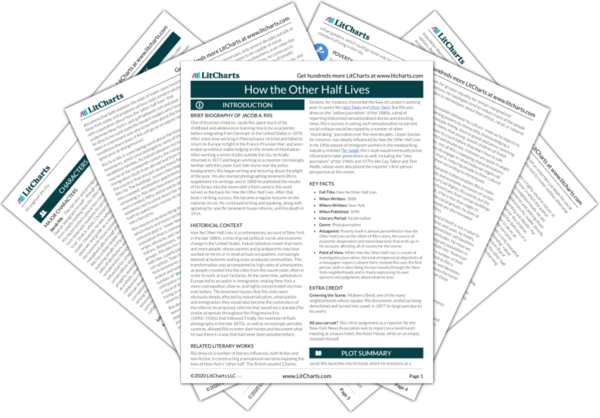As he moves throughout the slums and tenements of the city, Riis draws on his experience as an investigative reporter in uncovering the relationship between money, power, and poverty in and beyond these areas. Indeed, in addition to simply recounting the sights he sees, Riis exposes the underlying connections between the shocking conditions of New York’s poor as well as the complex, subtle manipulations that often work to keep them in their place.
For instance, Riis lingers over the relationship between saloons and political leadership: many of the rum shops crowding the tenements, which he contrasts with the coffee shops, parks, and libraries that could ideally take their place, are actually owned by some of the most powerful political leaders in the city—leaders who turn a profit off of the alcoholism of a population deprived of other cultural or social entertainment options. Rent gouging is another way the poor are exploited, according to Riis’s account: again, it is the most vulnerable populations who are the most likely to pay exorbitant prices on their rundown or even dangerous tenements, as landlords grow wealthy off of them.
Much of this is allowed to carry on, Riis argues, because of the relative neglect that characterizes the slums. Because policemen tend to turn a blind eye, and because more privileged people can easily forget that these places even exist, corruption can continue unchecked. Just as diseases like scarlet fever spread from block to block among the tenements without medical authorities taking action, so too do fraud and financial abuse snake their way through the alleys Riis explores. The graphs and tables that supplement Riis’s narrative are meant to provide evidence for these arguments, adding a quantitative claim of authority to the more descriptive, humanizing portrayals of life in the slums.
By analyzing the causes and sources of corruption, Riis aims to expose the way in which the city’s most vulnerable residents are taken advantage of by the more powerful—and are trapped in a cycle of poverty that becomes self-perpetuating, even if ultimately resolvable through reform.
Corruption ThemeTracker

Corruption Quotes in How the Other Half Lives
Long ago it was said that “one half of the world does not know how the other half lives.” That was true then. It did not know because it did not care. The half that was on top cared little for the struggles, and less for the fate of those who were underneath, as long as it was able to hold them there and keep its own seat. There came a time when the discomfort and crowding below were so great, and the consequent upheavals so violent, that it was no longer an easy thing to do, and then the upper half fell to inquiring what was the matter.

Unlock explanations and citation info for this and every other How the Other Half Lives quote.
Plus so much more...
Get LitCharts A+Might not the conference have found in the warning of one Brooklyn builder, who has invested his capital on this plan and made it pay more than a money interest, a hint worth heeding: “How shall the love of God be understood by those who have been nurtured in sight only of the greed of man?”
What if I were to tell you that this alley, and more tenement property in “the Bend,” all of it notorious for years as the vilest and worst to be found anywhere, stood associated on the tax-books all through the long struggle to make its owners responsible, which has at last resulted in a qualified victory for the law, with the name of an honored family, one of the “oldest and best,” rich in possessions and in influence, and high in the councils of the city’s government?
A number of [saloons], on the contrary, had brought their owners wealth and prominence. From their bars these eminent citizens stepped proudly into the councils of the city and the State. The very floor of one of the bar-rooms, in a neighborhood that lately resounded with the cry for bread of starving workmen, is paved with silver dollars!











